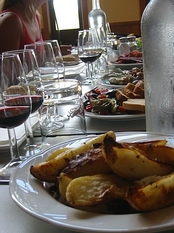I’m posting this column in the week of Thanksgiving, which is the one week during the year when food pairing is the topic preoccupying all wine lovers. My situation is a little different than most people’s, as I’ve been preoccupied with experiments in wine-and-food pairing for the entirety of the past year, and have hit upon some lessons that will change the wines that I pour at my table for years to come. One  finding is particularly pertinent for Thanksgiving dinner, but also for the austere economic climate to which we’ll return afterward.
finding is particularly pertinent for Thanksgiving dinner, but also for the austere economic climate to which we’ll return afterward.
I’ve been intensively focused on wine- and food-pairing for years, partly in connection with a restaurant consulting gig, and partly in my informal capacity as ravenous chowhound who also happens to taste wine for a living. As a result, I’ve been testing pairing principles for years, but this past year has involved a whole new level of experimental madness.
My wife has been testing recipes constantly for a cookbook she’s co-authoring (and for which I’m writing wine recommendations), so I’ve been gleefully free of galley chores, left with nothing to do but run between the table and the cellar to grab bottles to test this or that pairing hypothesis.
This has worked out for the two of us pretty much as you’d expect: I frequently declare, “I love this whole process!” whereas she continually vows, “This is the last book--I’m never doing this again!”
The book (to be published next year) is entitled, The Splendid Table’s  How to Eat Weekends, by Lynne Rosetto Kasper, host of public radio’s “The Splendid Table,” and the show’s managing producer, Sally Swift, who somehow blundered into a marriage to me in April.
How to Eat Weekends, by Lynne Rosetto Kasper, host of public radio’s “The Splendid Table,” and the show’s managing producer, Sally Swift, who somehow blundered into a marriage to me in April.
The book includes some simple foods, but focuses largely on more complex and exotic dishes (many inspired in Asia, Latin America or the Middle East) that home cooks might tackle on a weekend rather than during a hectic weeknight. Of course, it is the flavor complexity of the dishes that links them to Thanksgiving dinner, which involves a famously diverse--even discordant--collection of foods and flavors and textures.
What was the most surprising wine-pairing finding? Simple, straightforward young wines routinely out-perform complex wines at the table.
A few caveats and corollaries will help to clarify the meaning and importance of this finding:
1) Complex wines are intrinsically superior to simple ones on account of being more interesting in their multi-dimensionality, but that has little bearing on their performance with food. If one’s focus at the table is fixed on the quality of the match rather than the wine, simple wines like Pinot Blanc and Barbera regularly dish out drubbings to their more complex cousins, and do so while costing considerably less.
2) This principle is tested best with some patience. Evaluating matches rather than wines doesn’t come naturally or immediately to most people, especially wine lovers. It takes a little time and practice to really get focused on the interaction of foods and wines rather than focusing predominantly on one or the other. As with art or music, anybody can say what they “like” right off the bat, but fuller “appreciation” takes more time and attentiveness. In my experience, novices who are presented with two wines often get distracted by the one that would be more interesting if tasted in isolation, losing their focus on the interaction and getting suckered away from the better match offered by the simpler wine.
3) Complex, aged wines can indeed outperform simple wines at the table, but only with simple foods in many cases. Of course, there’s no law requiring you to care more about the complexity of food than wine. If you love old Bordeaux, you can be very happy at the table with it--provided that you are content to eat lots of simply prepared meat roasts.
4) However, the converse is also true: If you find roast beef a bit boring and want your meat braised with Middle Eastern spices and herbs, you’ll probably be happier at the table with a simple Tempranillo than a complex Bordeaux. And in lean economic times it is an important fact that complexity in food costs much less than complexity in wine.
5) Complexity in wine comes from three main sources, all of which involve expense. The first is a great growing site, and this is reflected in prices for vineyard land that show up at the cash register. Second is ageing time, which results either in inventory costs for producers or cellar construction and opportunity costs for consumers. Third are production techniques like vinification in fancy French oak barrels, which can cost nearly $1,000 apiece. By contrast, you could make at least a dozen roasts that smell and taste amazing by shelling out for a little cumin, coriander, cardamom, cinnamon and ground Aleppo chile, and those roasts will sing with a simple, affordable bottle of Cabernet or Syrah.
The cliché that “less is more” has always bugged me on grounds of illogic, but I confess that I’ve been surprised during the past year by how often it proves true when matching wines with complex foods.
For example, unwooded Chardonnay is usually a pretty nondescript wine category. I sometimes recommend particular bottlings, but I rarely award high scores to them. As a critical evaluator of wines, I’m more impressed by Chardonnays with oak-based accents of woodsmoke and vanilla and spices. However, as a wine-and-food taster, I found myself drawn repeatedly to unwooded Chardonnays with complex Asian dishes tasted for the How to Eat Weekends project. Again and again, the purity of unwooded Chardonnay would let the aromatic and flavor complexities of the food show themselves without oak accents contributing to a cacophony. The straightforward sweetness of the young, tank-fermented Chardonnay was a perfect foil for the spicy edge of the food, whereas the vanilla in an oaked version seemed disjointed and distracting, just as the wood notes in the finish seemed bitter when set against the food’s spiciness.
I can offer plenty of other examples, but first a word of warning: Although I’m making a strong claim for simple wines, I definitely don’t want to be misunderstood as making a claim for mediocre wines. “Simple” in this context is a stylistic term as I’m using it here, not a qualitative descriptor.
The type of wine that proved so surprisingly successful in our How to Eat Weekends trials were young, notably fruity, relatively affordable, unoaked or minimally oaked, and balanced in ripeness and structure. What enabled them to succeed was partly an absence of oak, overt earthiness, outlandish ripeness, or un-integrated acidity or tannin. Yet they also showed a positive presence of attributes like purity, freshness, integration and balance. The upshot of this is that not every unoaked Chardonnay will be a star at your table. However, the flip-side is that fine examples can indeed be stars on your table, out-performing oaked Chardonnays costing twice as much.
If you are open to the possibility that simple but well-made wines can prove to be great over-achievers at the table, the next step would be to start trying some of the world’s leading examples. Here are eleven white examples as well as ten reds to get you started:
Whites:
Muscadet from France’s Loire Valley
Chasselas from Switzerland
Pinot Blanc from Alsace or Austria, or Pinot Bianco from Friuli
Pinot Gris from Oregon
Garnacha Blanca / Grenache Blanc from Catalonia or the Rhône
Trebbiano from Abruzzo
Moschofilero and Roditis from Greece
Inexpensive Chenin Blanc or “Steen” from the Loire or South Africa
Verdelho from Australia
Inexpensive Grüner Veltliner from Austria
Reds:
Nero d’Avola from Sicily
Montepulciano from Abruzzo
Negramaro from Puglia
Inexpensive Barbera from Piedmont
Agiorghitiko from Greece
Inexpensive Pinot Noir from New Zealand
Tempranillo from Castilla y León
Garnacha from Navarra
Cariñena from Aragón
Zweigelt from Austria
Some of these grape varieties can make very complex wines, and that’s certainly true for Chenin Blanc, Grüner Veltliner, Pinot Noir and Barbera, so I’ve specified that it is inexpensive renditions of these wines (which will usually be young and unadorned by new wood) that I’ve got in mind.
In many cases, these are wines that wouldn’t likely stop you in your tracks if you encountered them in a lineup of wines at a tasting, but which can prove amazingly versatile and delicious with food.
If you are itching to test this claim, I would encourage you to try these wine types with your Thanksgiving dinner this year or next. Muscadet would probably be too light to work with everything on the typical Thanksgiving table and would be better with seafood, but I dare you to examine the food-pairing properties of any of the 10 reds or of the other 10 whites. Thanksgiving provides as stern a test as any meal of the entire year, and I predict that these wines will pass with flying colors and keep you feeling thankful for all the pleasure and value that they’ll provide at your table for years into the future.
* * *
Questions or comments? Write to me at mfranz@winereviewonline.com